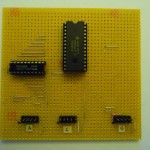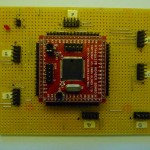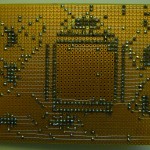Yesterday I finished the assembly of the new front panel controller board, which evolved out of the old display carrier board). The circuit signal lines have already been tested (using continuity testing) and I’m not far away from having the prototype be contained inside its case.
In the new board I basically merged the core board with the display carrier board, since there was enough space available. A slight change I introduced is that I adjusted some pin mappings (namely we moved the LCD control lines from port B to D).
Schematic and Circuit Board
PDF files for schematic and board.
Now I’m updating the wiki page of the prototypes to get things in sync again.








